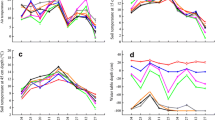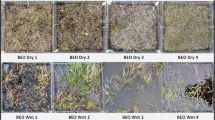Abstract
Duckweed (Lemna minor), a floating macrophyte belonging to the Lemnaceae family, is commonly found in subtropical paddy fields. This plant rapidly takes up nutrients from water and forms dense floating mats over the water surface that may impact the biogeochemical processes and greenhouse gas production in paddy fields. In this study, we measured CH4 and N2O emissions from duckweed and non-duckweed plots in a subtropical paddy field in China during the period of rice growth using static chamber and gas chromatography methods. Our results showed that CH4 emission rate ranged from 0.19 to 26.50 mg m−2 h−1 in the duckweed plots, and from 1.02 to 28.02 mg m−2 h−1 in the non-duckweed plots. The CH4 emission peak occurred about 1 week earlier in the duckweed plots compared to the non-duckweed counterparts. The mean CH4 emission rate in the duckweed plots (9.28 mg m−2 h−1) was significantly lower than that in non-duckweed plots (11.66 mg m−2 h−1) (p < 0.05), which might be attributed to the higher water and soil Eh in the former. N2O emission rates varied between −50.11 and 201.82 µg m−2 h−1, and between −28.93 and 54.42 µg m−2 h−1 in the duckweed and non-duckweed plots, respectively. The average N2O emission rate was significantly higher in the duckweed plots than in the non-duckweed plots (40.29 vs. 11.93 µg m−2 h−1) (p < 0.05). Our results suggest that the presence of duckweed will reduce CH4 emission, but increase N2O flux simultaneously. Taking into account the combined global warming potentials of CH4 and N2O, we found that growing duckweed could reduce the overall greenhouse effect of subtropical paddy fields by about 17 %.


Similar content being viewed by others

References
Ali MA, Lee CH, Kim PJ (2008) Effect of silicate fertilizer on reducing methane emission during rice cultivation. Biol Fertil Soils 44:597–604
Ali MA, Hoque MA, Kim PJ (2013) Mitigating global warming potentials of methane and nitrous oxide gases from rice paddies under different irrigation regimes. Ambio 42:357–368
Ali MA, Sattar MA, Islam MN, Inubushi K (2014) Integrated effects of organic, inorganic and biological amendments on methane emission, soil quality and rice productivity in irrigated paddy ecosystem of Bangladesh: field study of two consecutive rice growing seasons. Plant Soil 378:239–252
Baruah KK, Gogoi B, Gogoi P (2010) Plant physiological and soil characteristics associated with methane and nitrous oxide emission from rice paddy. Physiol Mol Biol Plants 79:73–83
Bharati K, Mohanty SR, Singh DP, Rao VR, Adhya TK (2000) Influence of incorporation or dual cropping of Azolla on methane emission from a flooded alluvial soil planted to rice in eastern India. Agric Ecosyst Environ 79:73–83
Chen GX, Huang GH, Huang B, Wu J, Yu KW, Xu H, Xue XH, Wang ZP (1995) CH4 and N2O emission from a rice field and effect of Azolla and fertilization on them. Chin J Appl Ecol 6(4):378–382 (in Chinese with English abstract)
Chen GX, Huang GH, Huang B, Yu KW, Xu H (1997) Nitrous oxide emissions from soil-plant systems. Nutr Cycl Agroecosyst 49:41–45
Chen W, Wolf B, Zheng X, Yao Z, Butterbach-Bahl K, Br Üggemann N, Liu C, Han S, Han X (2011) Annual methane uptake by temperate semiarid steppes as regulated by stocking rates, aboveground plant biomass and topsoil air permeability. Glob Change Biol 17:2803–2816
Cheng JJ, Stomp AM (2009) Growing duckweed to recover nutrients from wastewaters and for production of fuel ethanol and animal feed. Clean-Soil, Air, Water 37:17–26
FAO [Food and Agricultural Organization of the United Nations], 2009. OECD-FAO Agricultural Outlook 2011–2030
Gauci V, Dise NB, Howell G, Jenkins ME (2008) Suppression of rice methane emission by sulfate deposition in simulated acid rain. J Geophys Res 113:G00A07. doi:10.1029/2007JG000501
Hanke A, Cerli C, Muhr J, Borken W, Kalbitz K (2013) Redox control on carbon mineralization and dissolved organic matter along a chronosequence of paddy soil. Eur J Soil Sci 64:476–487
Hanson RS, Hanson TE (1996) Methanotrophic bacteria. Microbiol Rev 60:439–471
Hou H, Peng S, Xu J, Yang S, Mao Z (2012) Seasonal variations of CH4 and N2O emissions in response to water management of paddy fields located in Southeast China. Chemosphere 89(7):884–892
IPCC [Inter-Governmental Panel on Climate Change] (2007a). Climate change 2007: the physical science basis: summary for policymakers. Geneva
IPCC [Inter-Governmental Panel on Climate Change] (2007b) Technical Summary [M]//Climate Change 2007: The Physical Science Basis Contribution of Working Group I to the Fourth Assessment Report of the IPCC. Cambridge University Press, New York, pp 31–34
Itoh M, Sudo S, Mori S, Saito H, Yoshida T, Shiratori Y, Suga S, Yoshikawa N, Suzue Y, Mizukami H, Mochida T, Yagi K (2011) Mitigation of methane emissions from paddy fields by prolonging midseason drainage. Agric Ecosyst Environ 141:359–372
Jena J, Ray S, Srichandan H, Das A, Das T (2013) Role of microorganisms in emission of nitrous oxide and methane in pulse cultivated soil under laboratory incubation condition. Indian J Microbiol 53:92–99
Johnson-Beebout SE, Angeles CR, Alberto MCR, Buresh RJ (2009) Simultaneous minimization of nitrous oxide and methane emission from rice paddy soils is improbable due to redox potential changes with depth in a greenhouse experiment without plant. Geoderma 149:45–53
Kimura M, Miura Y, Watanabe A, Murase J, Kuwatsuka S (1992) Methane production and its fate in rice paddies I. Effects of rice straw application and percolation rate on the leaching into subsoil of methane and other soil components. Soil Sci Pl Nutr 38:665–672
Kudo Y, Noborio K, Shimoozono N, Kurihara R (2014) The effective water management practice for mitigating greenhouse gas emissions and maintaining rice yield in central Japan. Agric Ecosyst Environ 186:77–85
Lai DYF (2009) Methane dynamics in northern peatlands: a review. Pedosphere 19:409–421
Li H, Liang X, Lian Y, Xu L, Chen Y (2009) Reduction of ammonia volatilization from urea by a floating duckweed in flooded rice fields. Soil Sci Soc Am J 73:1890–1895
Liu WZ, Liu GH, Zhang QF (2011) Influence of vegetation characteristics on soil denitrification in shoreline wetlands of the Danjiangkou Reservoir in China. Clean-Soil, Air, Water 39:109–115
Luo GJ, Kiese R, Wolf B, Butterbach-Bahl K (2013) Effects of soil temperature and moisture on methane uptake and nitrous oxide emissions across three different ecosystem types. Biogeosciences 10:3205–3219
Myhre G, Shindell D, Bréon FM, Collins W, Fuglestvedt J, Huang J, Lamarque JF, Lee D, Mendoza B, Nakajima T, Robock A, Stephens G, Takemura T, Zhang H (2013) Anthropogenic and Natural Radiative Forcing. In: Stocker TF, Qin D, Plattner G-K, Tignor M, Allen SK, Boschung J, Nauels A, Xia Y, Bex V, Midgley PM (eds) Climate Change 2013: The Physical Science Basis. Contribution of Working Group I to the Fifth Assessment Report of the Intergovernmental Panel on Climate Change. Cambridge University Press, Cambridge, New York, p 714
Peng S, Hou H, Xu J, Mao Z, Abudu S, Luo Y (2011) Nitrous oxide emissions from paddy fields under different water managements in southeast China. Paddy Water Environ 9:403–411
Qin Y, Liu S, Guo Y, Liu Q, Zou J (2010) Methane and nitrous oxide emissions from organic and conventional rice cropping systems in Southeast China. Biol Fertil Soils 46:825–834
Sengupta S, Medda C, Dewanji A (2010) The impact of duckweed growth on water quality in sub-tropical ponds. Environmentalis 30:353–360
Smith P, Martino D, Cai Z, Gwary D, Janzen H, Kumar P, McCarl B, Ogle S, O’Mara F, Rice C, Scholes B, Sirotenko O, Howden M, McAllister T, Pan G, Romanenkov V, Schneider U, Towprayoon S (2007) Policy and technological constraints to implementation of greenhouse gas mitigation options in agriculture. Agric Ecosyst Environ 118:6–28
Song CC, Wang LL, Tian HQ, Liu DY, Lu CQ, Xu XF, Zhang LH, Yang GS, Wan ZM (2013) Effect of continued nitrogen enrichment on greenhouse gas emissions from a wetland ecosystem in the Sanjiang Plain, Northeast China: A 5 year nitrogen addition experiment. J Geophys Res 118:741–751
Sutton-Grier AE, Megonigal JP (2011) Plant species traits regulate methane production in freshwater wetland soils. Soil Biol Biochem 43:413–420
Van der Steen NP, Nakiboneka P, Mangalika L, Ferrer AVM, Gijzen HJ (2003) Effect of duckweed cover on greenhouse gas emissions and odour release from waste stabilization ponds. Water Sci Technol 48(2):341–348
Van Rijn J (1996) The potential for integrated biological treatment systems in recirculating fish culture—a review. Aquaculture 139:181–201
Veraart AJ, de Bruijne WJJ, de Klein JJM, Peeters ETHM, Scheffer M (2011) Effects of aquatic vegetation type on denitrification. Biogeochemistry 104:267–274
Vibol S, Towprayoon S (2010) Estimation of methane and nitrous oxide emissions from rice field with rice straw management in Cambodia. Environ Monit Assess 161:301–313
Wang WQ, Li PF, Zeng CS, Tong C (2012a) Evaluation of silicate iron slag as a potential methane mitigating method. Adv Mater Res 468:1626–1630
Wang Z, Zhang ZY, Zhang JQ, Zhang YY, Liu HQ, Yan SH (2012b) Large-scale utilization of water hyacinth for nutrient removal in Lake Dianchi in China: the effects on the water quality, macrozoobenthos and zooplankton. Chemosphere 89:1255–1261
Xing GX, Shi SL, Shen GY, Du LJ, Xiong ZQ (2002) Nitrous oxide emissions from paddy soil in three rice-based cropping systems in China. Nutr Cycl Agroecosyst 64:135–143
Ying Z, Boeckx P, Chen GX, Cleemput OV (2000) Influence of Azolla on CH4 emission from rice fields. Nutr Cycl Agroecosyst 58:321–326
Yu K, Faulkner SP, Patrick JWH (2006) Redox potential characterization and soil greenhouse gas concentration across a hydrological gradient in a Gulf coast forest. Chemosphere 62:905–914
Zhu X, Burger M, Doane TA, Horwath WR (2013) Ammonia oxidation pathways and nitrifier denitrification are significant sources of N2O and NO under low oxygen availability. PNAS 110:6328–6333
Acknowledgments
The authors would like to thank Na Zhao, and Dehua Lin for their assistance with field sampling. Funding was provided by the National Science Foundation of China (31000209), Natural Science Foundation of Fujian Province (2014J01119), Natural Science Foundation of Jiangxi Province of China (20132BAB204006), Educational Commission of Jiangxi Province of China (GJJ13241), Key Laboratory of Functional Small Organic Molecule, Ministry of Education (KLFS-KF-201225), and The Chinese University of Hong Kong (SS12434).
Author information
Authors and Affiliations
Corresponding author
Rights and permissions
About this article
Cite this article
Wang, C., Li, S., Lai, D.Y.F. et al. The effect of floating vegetation on CH4 and N2O emissions from subtropical paddy fields in China. Paddy Water Environ 13, 425–431 (2015). https://doi.org/10.1007/s10333-014-0459-6
Received:
Revised:
Accepted:
Published:
Issue Date:
DOI: https://doi.org/10.1007/s10333-014-0459-6



